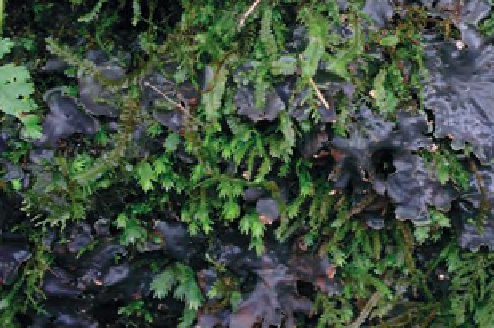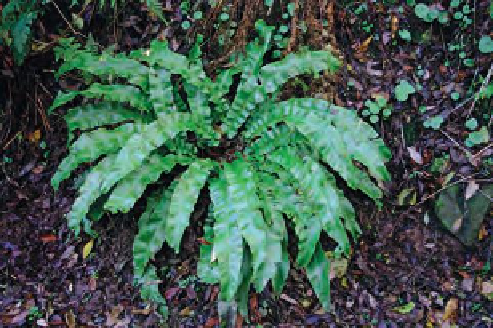Agriculture Reference
In-Depth Information
What is a plant?
The world of living organisms can be grouped in many
ways. One such classification is the five kingdom
system:
X
Plantae (plants)
X
Animalia (animals)
X
Fungi
X
Prokaryota (bacteria)
X
Protoctista (all other organisms that are not in the
other kingdoms, including algae and protozoa).
What distinguishes the plant kingdom from the other
four kingdoms? Plants are largely sedentary and live
on land (albeit some in aquatic environments such
as ponds and rivers). They are multicellular and their
cells have cellulose cells walls and a nucleus. Most
importantly, they are
autotrophs
(the 'producers'
described on p. 38), organisms that are able to convert
energy from one form, that is light, into a chemical
form stored in organic molecules such as sugar and
starch through the process of photosynthesis (see
Chapter 9). Animals, among other things, have no
cell walls and are
heterotrophs
(the 'consumers'
described on p. 38). They rely on eating ready-made
organic molecules for their nutrition and feed on plants
and other organisms. Fungi do not photosynthesize
and although some algae and bacteria do so, the
former are aquatic organisms and the latter do not
have a nucleus.
The plant kingdom contains a range of plant groups
which reflect their evolutionary pathway from simple
organisms, such as mosses and liverworts, to the
more advanced conifers and flowering plants. Mosses
and liverworts are the most primitive and are termed
'
non-vascular
' plants as they have no specialized
tissue for conduction of water and minerals
(Figure 4.2). This, together with the need for water
Figure 4.3
Hart's tongue fern (
Asplenium
scolopendrium
) a native British fern
for reproduction, limits their size and restricts them
to damp shady habitats. Mosses may be a problem
weed in some circumstances, particularly in shaded
and poorly drained lawns, but may also be used as an
ornamental feature in Japanese gardens.
The '
vascular
' plants contain conducting tissue (xylem
and phloem) (see Chapter 6) and range from ferns to
higher plants such as gymnosperms, which include
conifers, and angiosperms (the flowering plants).
The '
lower vascular plants
', of which ferns are an
example (Figure 4.3), spread by means of spores,
in common with the non-vascular plants. They also
require water for reproduction so tend to be found in
damp places. Ferns provide a wide range of decorative
plants in the garden and as houseplants, with many
attractive leaf shapes and forms and a variety of sizes.
They are especially useful for planting in shade.
In contrast, the '
higher vascular plants
', the
angiosperms and the gymnosperms, which are more
evolutionarily advanced, produce seed and spread
by this means rather than by spores. It is mostly the
higher plants which will be examined in this topic as
they represent by far the biggest and most diverse
group of plants used in horticulture.
Plant classification - families,
genera and species
Classification involves putting objects or organisms into
groups based on characteristics which the members
of the group share, it is something we do all the time
and it is very useful. For example, the fresh produce
section of the supermarket contains a salad section, a
vegetable section and a fruit section. The fruit section in
turn is subdivided into smaller groupings such as citrus
(oranges and lemons), top fruit (apples and pears) and
soft fruit (strawberries, blackberries and raspberries).
Figure 4.2
A feathery green moss and a purple
liverwort growing on a wet rock. The liverwort
structures are approximately 1 cm long


